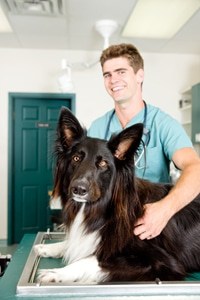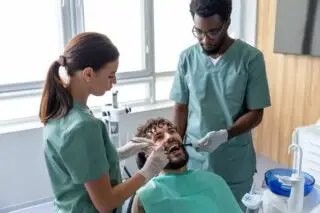 The world of animal medicine has seen drastic technological advances in the last 20 years. Many of the new tools and procedures have been adopted from human medical practice. The advances have not only led to better treatments, but also faster and more accurate diagnosis. From MRIs and Ultrasounds to the Amplatz Canine Ductal Occluder, there are many new technologies that are giving veterinarians greater ability to diagnose and ultimately save sick animals. Here are some of the most exciting new developments in veterinary technology:
The world of animal medicine has seen drastic technological advances in the last 20 years. Many of the new tools and procedures have been adopted from human medical practice. The advances have not only led to better treatments, but also faster and more accurate diagnosis. From MRIs and Ultrasounds to the Amplatz Canine Ductal Occluder, there are many new technologies that are giving veterinarians greater ability to diagnose and ultimately save sick animals. Here are some of the most exciting new developments in veterinary technology:
Magnetic resonance imaging
MRI technology has been extremely influential in the progression of human neuroscience. Vets are now using the imaging technology to look into the brains of pets and other animals.1 However, the powerful technology is not limited to brain scans. MRIs are also very effective for getting scans of orthopedic and soft tissue structures prior to surgery. By being able to see what is going on inside the animal before going in for surgery, a vet is able to reduce the chance that anything will go wrong during the procedure.
Ultrasounds
As powerful as MRIs certainly are, they are also very expensive. In order to get an accurate image, the animal must remain completely still, thus anesthetics are required. The high cost and need for anesthesia makes it difficult for MRI procedures to be widely adopted. Ultrasound imaging technology, however, is much cheaper and has the potential to become universally adopted by vets.1 You may recognize the word “ultrasound” if you or anyone you know has become pregnant. The ultrasound is the preferred method of creating images of fetuses as they develop inside the mother. However, they are now being used to take 3-D and even 4-D images of patients’ hearts by cardiovascular specialists. Ultrasounds have the advantage of not requiring anesthesia and being relatively cheap to perform.
Laparoscopy
Laparoscopic procedures use a small camera and light source that can be inserted into the abdominal or thoracic cavity to see inside the body. This is yet another example of a human medicine technology being adapted to the animal kingdom. These procedures are less invasive than most surgical operations and produce a clear image. The first widely reported laparoscopic procedure was in 2011 when the Royal Zoological Society of Scotland used it to remove diseased gallbladders from moon bears.
Microfracture detection
One of the greatest threats to the health of thoroughbred racehorses is bone failure.2 During training, horses will often develop microscopic bone fissures that can quickly turn into fatal full-fledged fractures. In order to prevent this from happening, researchers have developed a method of detecting the sonic waves that these micro-fissures produce. Early detection is key to the successful preventative care of equine bone health.
3-D printing
The ability to print three-dimensional objects is one of the most often-discussed topics in technology today. This rapid-prototyping process has been applied to veterinary practice to create animal bone models from the information gathered from computed tomography scans.3 Doing so enables vets and surgeons to have a solid grasp of a patient’s internal bone or muscle structure before going in to operate. In addition, the models help educate pet owners about the anatomy and physiology of their pets.
Recombinant DNA
Recombinant DNA has laid the groundwork for a whole host of biotechnological advances.4 Before its discovery, protein drugs such as insulin, somatotropin and prolactin were somewhat difficult to produce. rDNA not only allows for cheaper and more efficient drug production, it also opens up the possibility of gene therapy. Such a procedure would allow vets to replace missing or broken genes in animals to treat a range of different maladies. However, they have been met with a range of ethical concerns as experts debate the possible effects of altering animal genomes. While the discussion rages on, rDNA technology continues to become more advanced, to the point where scientists are now discussing the ability to bioengineer not only animals, but their feed as well. With the development of new veterinary technology comes the greater need for those with specialized training. Being a veterinary technician is a rewarding career for anyone who has a passion for animals. Vet techs work closely with the veterinarians to ensure that animal patients are properly cared for. In this challenging yet exciting line of work, you will be responsible for many tasks including maintaining medical records, collecting laboratory specimens and assisting with radiography and dental prophylaxes. Since the job is very demanding, it requires individuals with high levels of training. Successful vet techs will need to have completed substantial theoretical work in chemistry, biology, anatomy and physiology as well as practical work on live animals and animal simulators. Upon graduation, students need to take the Veterinary Technician National Exam to become a fully certified vet tech. 1“New Advances in Technology for Pets,” Veterinary Medicine and Biomedical Sciences, Texas A&M University, http://vetmed.tamu.edu/news/pet-talk/new-advances-in-technology-for-pets#.U3Z9lPldWRN 2“New technology could help reduce bone fractures in horses,” James M Lewis, dvm360, http://veterinarynews.dvm360.com/dvm/Veterinary+Equine/New-technology-could-help-reduce-bone-fractures-in/ArticleStandard/Article/detail/529567 3“Pet Talk: Advances in technology affect veterinary medicine,” Sarah Netherton, The News-Gazette, 4“Developments in New Animal Technologies Show Rapid Advancement,” Suzanne Sechen, Ph.D., FDA Vetrenarian Newsletter, http://www.fda.gov/animalveterinary/newsevents/fdaveterinariannewsletter/ucm085008.htm



